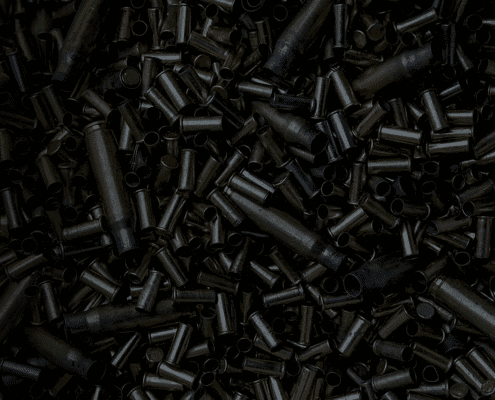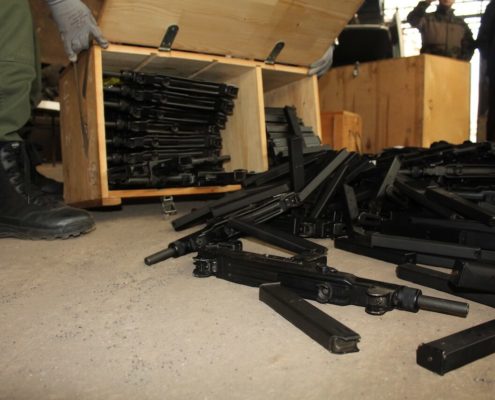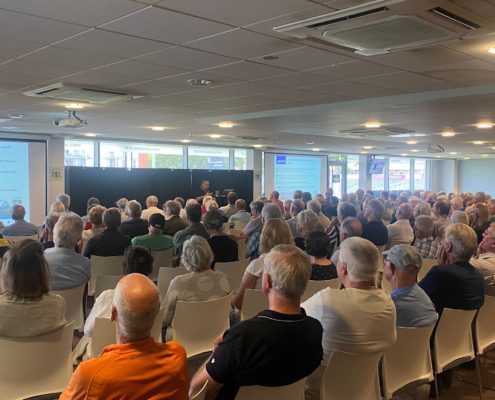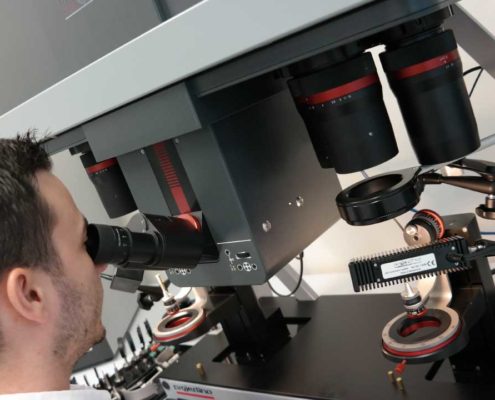 https://arquebus.uk/wp-content/uploads/2025/02/Picture-1-3.png
323
473
Rohan Harvey
https://arquebus.uk/wp-content/uploads/2022/02/Asset-1arquebus_logo.svg
Rohan Harvey2025-02-10 10:04:322025-02-10 15:23:07Arquebus Delivers Ballistic Examination Training in Montenegro
https://arquebus.uk/wp-content/uploads/2025/02/Picture-1-3.png
323
473
Rohan Harvey
https://arquebus.uk/wp-content/uploads/2022/02/Asset-1arquebus_logo.svg
Rohan Harvey2025-02-10 10:04:322025-02-10 15:23:07Arquebus Delivers Ballistic Examination Training in MontenegroThe misuse of SALW represents a significant threat to public safety, requiring the state to effectively leverage its resources to level the playing field against criminals operating in an ever-evolving security environment. National Firearms Focal Points (NFFPs) provide an integrated tactical and strategic intelligence service that informs and supports law enforcement agencies in better understanding and effectively tackling SALW-related criminality, minimising the risk of SALW misuse at both the national and international level.
For this month’s article, Arquebus talks to Lorenzo Benedet, a Major in the Spanish Guardia Civil and Head of the Spanish NFFP, to discuss the role that NFFPs play in combatting SALW criminality as part of a national SALW control strategy (NSCS).
SALW security threats are increasingly complex. Exacerbated by growing interconnectedness and the increasingly diffuse and accelerated flows of information, goods, people and capital resulting from globalisation processes, the uncontrolled proliferation of SALW to malicious non-state actors presents a unique threat to security by subverting the state’s legitimate monopoly on the use of force.
As durable, portable and ubiquitous dual-use goods, a variety of different individuals and groups such as OCGs and NSAGs could misuse a weapon numerous times within one jurisdiction, before it being illicitly trafficked across borders for it to be misused elsewhere. Technological advancements have also allowed criminals to manufacture viable SALW on a larger scale and manufacture weapons that are difficult for authorities to trace. This complex intelligence picture ensures that states require a diverse assortment of expertise across the legislature, judiciary, law enforcement and forensics to effectively meet the threat posed by SALW misuse.
Central to understanding this complex intelligence picture are NFFPs. NFFPs leverage data, framework, personnel, and technology on a multi-agency basis to improve “… the intelligence picture concerning the use of criminally held firearms and illicit trafficking activities” (Brown and Poole, 2016).
The NFFP model is not ‘one size fits all’ and should be adapted to the local security context. For example, an NFFP might be a centralised national service such as NABIS, or a ‘virtual’ NFFP which utilises a single point of contact to coordinate multiple yet distinct services to operate as an NFFP. In some contexts, NFFPs might also focus on explosives and squad-level light weapons too. Further to this, an NFFP’s intelligence focus might be tactical, strategic, or a combination.
For example, at the tactical level, some NFFPs take a ‘presumptive approach’ to SALW misuse, collating and integrating data from inside and outside the gun to identify the illicit origins of every recovered or seized firearm. Through the rapid analysis of weapons, ballistic material and other associated materials, NFFPs and forensic laboratories can provide law enforcement with fast-time intelligence products that uncover new investigative opportunities within the ‘golden hours’ or ‘golden days’ of an investigation.
At the strategic level, NFFPs might develop intelligence which identifies victims, perpetrators, modus operandi and trends to aid law enforcement in developing strategy which tackles and prevents SALW threats to public safety, in addition to the ‘big picture’ intelligence which informs evidenced based policy development and intelligence-led policing.
Arquebus is delighted to welcome Lorenzo Benedet, a Major in the Guardia Civil, Head of the Spanish NFFP and Action Leader of the Operational Action (OA) 9.1 the Administrative Approach in EMPACT Firearms, to share his insight on NFFPs and the role they have within a NSCS.
§
Firstly, Lorenzo, please could you introduce yourself and outline your experience for our audience?
My name is Lorenzo Benedet, I’m a Major in the Spanish Guardia Civil, and now I’m the Head of the Spanish NFFP. I was assigned to this unit in August 2022, and finally I became the Head of the NFFP in December 2022.
Since then, I’ve been in charge not only of the unit, but also other tasks such as being an Action Leader of the OA 9.1 the Administrative Approach in EMPACT Firearms, as well as being the Executive Director of ISF-funded project FOCAL-SF, in which Arquebus participated.
Other important tasks include our participation as mentors in the CEPOL training program to support Ukraine in the establishment of their own NFFP. We started to work with them during the last summer and now we are in Sweden, in an activity discussion in the framework of this project.
And for those that don’t know the concept of an NFFP, in a short way, should be a kind of national central bureau in firearms, in which a country can concentrate and produce the strategic intelligence about firearms, operational intelligence, ballistics, statistical data at national level. This includes data such as firearm seizures or violent crimes involving firearms, and, also, the traceability of all the firearms found or seized. Finally, at the international level, an NFFP has an important impact for the information and intelligence exchange with other EU Member States and third countries.
Overall, NFFPs are vital to tackling the threat of the illicit trafficking, the illicit use and illicit production of firearms, and have proved an especially valuable tool in fighting organised crime here in the European Union.
Based on FOCAL-SF’s findings, and your own experience as Head of an NFFP, what key insights and advice would you give to jurisdictions that wish to establish a successful NFFP?
The first thing for me would be to analyse the different European documentation on the subject, such as the EMPACT-EFE Best Practice Guide for the establishment of NFFPs and the relevant Council Conclusions. Also consider the EU Action Plan on Firearms Trafficking 2020-2025, the EU Strategy against Organized Crime 2021-2025, the Europol SOCTA, and the EMPACT Operational Action Plans.
With this information in mind, the second step will be to decide on the organisational structure and reporting lines of the NFFP, such as whether it will be attached to the investigative unit, the forensic department, the arms control unit, or the international department, for example. This is a national decision and depends on the respective structure and roles each agency has within a jurisdiction – here in Spain, our NFFP is located within the Weapons and Explosives Control Unit of the Guardia Civil.
Once these decisions have been made, the legal basis of the NFFP must be established to provide the NFFP with the necessary legal support. Following this, the tasks, functions, and relationships with other agencies must then be developed.
To achieve all the above, it is necessary that the participation of the decision makers be aligned with those responsible for establishing the NFFP. In this sense, it is also important not to forget the support that can be found at the international level, such as the OA 1.2 led by the European Commission (DG-HOME), which aims to harmonise the development of the NFFPs and standardise the procedures for obtaining information at the European level.
In terms of funding, there are various tools that can be used, such as the Low Value Grant for operational funding, the High Value Grant, or EU Internal Security Fund (ISF) grants for more ambitious projects. This was the case for FOCAL-SF in which Arquebus, the Guardia Civil of Spain, the Securança Pública Police of Portugal and the National Police of Romania participated in the development of their NFFPs. And of course, we are asking for funding for FOCAL-SF 2 from the most recent ISF call to further develop the NFFPs in Spain, Romania, Portugal, Moldova, and Austria, and counting with the participation of Ukraine and Belgium.
Does this advice differ for NFFPs outside of the EU, or for those in unstable or fragile contexts?
No, in general terms. What jurisdictions outside of the EU must consider is that there are databases and certain legislation that is specific to the EU, and they will have to assess their own situation and adapt their response accordingly.
On the other hand, the structure, functions, and responsibilities of the different agencies, such as the police, military, administrative authorities, and customs and borders, should be considered in each jurisdiction so that their participation or integration in the NFFP can be accurately assessed. For example, in some Latin-American countries the control of the civilian firearms is tasked to the armed forces, so you need to have those units working with the NFFP in combatting illicit trafficking, misuse and manufacturing too.
What barriers are there to the implementation of effective NFFPs, both within the EU and its neighbourhood?
Mainly there is a need for adequate regulatory development that provides a sufficiently concrete legal basis for a framework that covers all the necessary actors, either by their integration in the NFFP or by their collaboration with it. This also needs to be flexible enough to make changes in procedures and information flows when needed.
Sometimes there isn’t sufficient political commitment to establish NFFPs. If you don’t reach out to decision-makers to explain their importance, you will never be able to have an adequate legal framework with which to support an NFFP. Security initiatives such as EMPACT Firearms, and documents such as the Council Conclusions on NFFPs, the Europol SOCTA and the EU Action Plan on Firearms Trafficking, certainly help to generate political will in these circumstances, in addition to the Program of Action, the Firearms Protocol, and the International Tracing Instrument of the UN.
From an operational perspective, it is difficult to obtain personnel with the appropriate profile, due to the need for experience in different fields. NFFP staff are required to be trained in the use of international law enforcement information exchange tools such as INTERPOL’s iARMS system, possess language skills for participation in international forums, and have sufficient knowledge regarding arms trafficking and relevant legislation on firearms control, making personnel difficult to find.
How do you manage the quality of the Spanish NFFP’s output?
Although the Spanish NFFP has limited staff, we maintain quality by ensuring the established procedures are followed consistently, and that data is vigilantly checked for errors.
This is an important issue, since we respond to trace requests from different national and international partners, and any mistake or misunderstanding in those requests can compromise firearms investigations. We are also responsible for the UNODC’s Illicit Arms Flow Questionnaire, in which we must provide a complete dataset about firearms seizures, including the criminal context and other firearm information such as the make, model, calibre, and so on.
However, there is always room for improvement, particularly in the quality of the data recorded in the different source databases given that they are utilised by many people across different agencies.
For me, the next step must be the harmonisation of data collection for firearms seizures at a European level, with minimum standards implemented across all EU Member States, to develop a better intelligence picture of the threat we all face. In this regard, Spain collaborates actively with the European Commission, with Spain being co-leader on EMPACT Firearms OA 1.2. I’m also aware of Arquebus’ involvement in a proposal for a project which specifically addresses firearms incidents and seizure data collection in the EU, in answer to the most recent ISF call.
In your view, what place do NFFPs have within an effective NSCS?
I think a fully developed NFFP is vital to an NSCS. The NFFP basically functions as a national firearms headquarters, having a complete picture of the SALW-related threat in a country. It therefore can identify potential victims, perpetrators and facilitators, as well as modus operandi and crime trends. This means it possesses the expertise and knowledge required to develop and implement an appropriate NSCS. At the very least, the NFFP should be consulted by the body responsible for its implementation and that the NFFP’s intelligence output should shape the development of the NSCS going forward.
From Arquebus’ experience in implementing NFFPs, we find that it’s vital that the intelligence cycle is completed so that the NFFP can inform upstream activity – could you tell us about how this can help NFFPs facilitate situational crime prevention?
Absolutely, this is what OA 9.1 on the Administrative Approach is all about. NFFPs utilise numerous sources of data and work with partners across multiple agencies to gather information to tackle firearm threats and develop the overall intelligence picture. By maintaining these partnerships, the NFFP can better identify vulnerabilities and identify the facilitators of criminality, and then put in place the necessary signals and barriers that can be used to address them.
For example, an NFFP might recognise a trend in instances where individuals initially deemed safe to legally possess a firearm have later received diagnoses for mental health conditions which impact their suitability and safety. The NFFP could then assess the threat this trend posed to public safety through analysing relevant data and consulting with health professionals. If these threats are considerable, it should review the present system to identify its vulnerabilities and then promote the necessary administrative changes that would mitigate and ultimately prevent the threat of firearms misuse.
§
In summary, this blog post and Q&A has provided an overview of the NFFPs concept and purpose, as well as the key considerations to make when implementing an NFFP as part of a successful NSCS.
Next month’s post shall investigate how the marking of SALW, their components and ammunition improves their traceability, both deterring SALW from entering illicit circulation and aiding authorities in the recovery of SALW.








